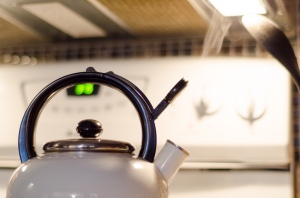Ayurveda considers removing toxins and impurities from the physiology, and preventing their build-up in the tissues, to be a key part of staying healthy. Ayurveda refers to these toxins and impurities as “ama”. Because ama disrupts the delicate biochemistry in the tissues and blocks the channels of circulation and communication within the physiology, it is a contributing factor in many physical disorders. The build-up of ama often starts with poor digestion. A sluggish digestion creates toxins and poor elimination, which allows the toxins to be absorbed into the circulation system and transported throughout the body.
Many of the recommendations given by Ayurveda experts during a consultation address the need for internal cleansing or detoxification. Of those that can be done at home, sipping hot water throughout the day is easy and effective.
Hot water flowing through the digestive tract helps to dissolve impurities and cleanse the digestive and eliminative systems. The result is an improvement in digestion and assimilation of food, improved elimination, and prevention of the formation of ama.
In addition, the hot water is absorbed into the circulatory system and travels throughout the entire body. The extra warmth and fluid aids in opening all the various channels of circulation, dissolving accumulated impurities and washing them from the body.
Many people report that after just a few weeks of sipping hot water throughout the day, digestion and elimination has improved and they feel fresher, lighter and more energetic.
Drinking hot water (water which just cool enough to be sipped comfortably) is especially helpful during vata and kapha season. During the hot summer months, warm or room-temperature water may be preferred, especially for those with pitta body types or with pitta-related disorders.
Ideally, Ayurveda recommends that water be boiled for ten minutes. Boiling the water allows excessive minerals deposits and impurities to precipitate out and increases the water’s lightness and its cleansing influence.
A slice of fresh ginger root, a pinch of turmeric or a few fennel seeds may be added to the boiling water if desired. These herbs can help increase the cleansing influence of the water in your system. Lemon may be added if it is not upsetting to the stomach.
For more information on Ayurveda consultations, visit The Raj Ayurveda Health Spa:





